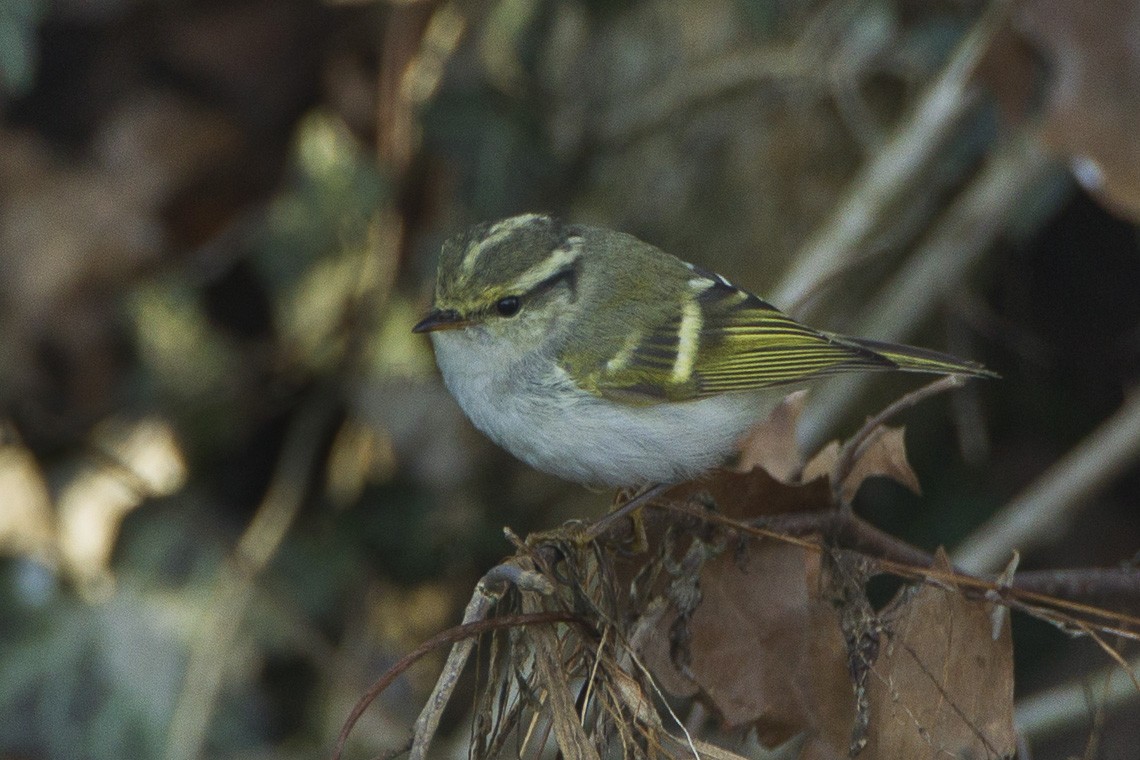Pallas's Leaf Warbler
A species of Chiffchaffs And Allies Scientific name : Phylloscopus proregulus Genus : Chiffchaffs And Allies
Pallas's Leaf Warbler, A species of Chiffchaffs And Allies
Botanical name: Phylloscopus proregulus
Genus: Chiffchaffs And Allies
Content
Description General Info
 Photo By Francesco Veronesi , used under CC-BY-SA-2.0 /Cropped and compressed from original
Photo By Francesco Veronesi , used under CC-BY-SA-2.0 /Cropped and compressed from original Description
Pallas's leaf warbler is one of the smallest warblers, with a large head and short tail. At 9–10 centimetres (3.5–3.9 in) long and 4–7 grams (0.14–0.25 oz) in weight, it is slightly smaller than a yellow-browed warbler and barely any larger than a goldcrest. It has greenish upperparts and white underparts, but is very striking, with prominent pale yellow double wingbars on the wing covert feathers, bold yellow supercilia and central crown stripe, and a lemon-yellow rump. The bill is blackish-brown with a yellowish tinge to the cutting edges and the base of the lower mandible, the iris is brown, and the legs are brown with a green or greyish tinge. Although the yellow rump is obvious when a bird is low in vegetation or hovering, it can otherwise be hard to see. In Asia, Pallas's leaf warbler can be distinguished from its former subspecies by its yellower head stripes, wingbars and throat as well as its different vocalisations. Other yellow-rumped Asiatic warblers resemble Pallas's; buff-barred and Brooks's leaf warblers are larger, much duller green above and less strongly marked, and their wing bars are buff and white respectively, not yellow. Ashy-throated warbler has grey head markings, face and throat, and pale yellow underparts. The sexes of Pallas's leaf warbler have similar plumage, but non-breeding birds are somewhat brighter green above and have broad, bright fringes to their flight feathers. Juveniles are like the adults, but have a brown tinge to the upperparts, greyish-white underparts and a duller supercilium. Adults have a complete post-breeding moult in August or September before migrating south. Juveniles and pre-breeding adults have a partial moult in March or April, replacing all the body plumage and some tail feathers. The song of Pallas's leaf warbler is delivered from a concealed perch near the top of a tall tree. It is strong and prolonged, with a medley of whistles, tirrit-tirrt-tirrit-terchee-choo-choo-chee-chee-chee or similar, with some phrases reminiscent of a canary, and interspersed trills. It lasts 2–4 seconds and may be heard in the winter quarters as well as from breeding birds. The call is a short, soft dju-ee. In contrast, the former subspecies have quite different songs, with sustained rattles for several seconds, or sometimes minutes. Their calls are typically sharp and monosyllabic. 
Size
10 cm
Nest Placement
Tree
Feeding Habits
Pallas's Leaf Warbler primarily consumes insects such as flies, aphids, and small moths, along with spiders and their developmental stages. Skilled at foraging, it exhibits unique dietary preferences that cater to insect variety within its habitat.
Habitat
Pallas's Leaf Warbler primarily inhabits the taiga coniferous forests rich in fir, spruce, pine, and larch trees. These birds are found in forested regions with a high density of conifers, reaching altitudes of approximately 1500-1700 meters in mountainous areas. During the non-breeding season, pallas's Leaf Warbler's habitat preferences expand to include coniferous, mixed, and deciduous broadleaf forests across broader geographical regions.
Dite type
Insectivorous
General Info
Feeding Habits
Bird food type
Bird Feeder Type

Small Tube Feeder
Behavior
Pallas's leaf warbler is not wary but its unobtrusive arboreal lifestyle makes it difficult to observe, particularly in thick foliage. It is constantly in motion, and often hovers briefly like a goldcrest, although more frequently, and may sometimes hang upside-down. 
Distribution Area
Pallas's leaf warbler breeds in coniferous taiga forests including fir, spruce, pine and larch, or in mixed forest with rhododendron, karsu oak and a high percentage of conifers. In southern Russia, it was found breeding at up to 1,500–1,700 metres (4,900–5,600 ft). In winter, it uses a wider range of habitats, including broadleaf forest and scrub as well as conifers, and can be found in river valleys down to 100 metres (330 ft). Pallas's leaf warbler breeds in Siberia from the Altai Mountains east to the Sea of Okhotsk, northern Mongolia, northeast China and possibly North Korea. It is strongly migratory and winters mainly in subtropical south China, northern Thailand and elsewhere in northeastern Indochina. It is rare but annual in Japan. 
Species Status
The Pallas's leaf warbler has a large range, and although global population trends have not been quantified, numbers are believed to be stable. This species does not approach the thresholds for the population decline criterion of the IUCN Red List (that is, declining more than 30 percent in ten years or three generations). For these reasons, it is evaluated as of "least concern" by the IUCN. Pallas's leaf warbler is widespread, common and locally abundant in Russia and northeast China. Breeding densities of up to 35–50 pairs/km (90–130 pairs/mi) have been recorded in southeast Russia, with only slightly lower figures in Siberia. It is locally common in parts of its wintering grounds in southeast Asia. 
Scientific Classification
Phylum
Chordates Class
Birds Order
Perching birds Family
Phylloscopidae Genus
Chiffchaffs And Allies Species
Pallas's Leaf Warbler